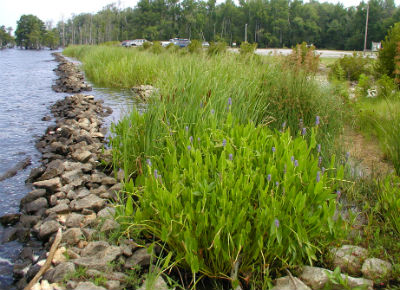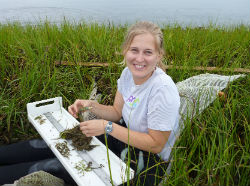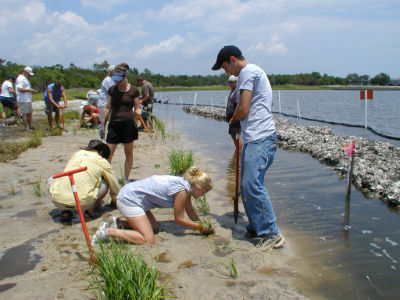First of two parts
 Lush marsh grass grows behind a rock sill at a living shoreline project near Edenton. |
You don’t have to get your feet wet or willingly serve as mosquito bait to know that “living shorelines” – the use of natural materials, such as rocks, oyster shells and planted marsh grass to slow the erosion of the banks of estuarine rivers and sounds – are rapidly gaining favor.
Just Google the phrase and you’ll turn up 1.4 million or so hits, with articles detailing new or ongoing projects from Maine to Florida and Seattle to San Francisco, and all along the Gulf of Mexico. Heck, one article, on the DCMilitary.com web site, notes that even the U.S. Navy, known more for blowing things up than for being warm, fuzzy and green, is in on the action, recently completing a 17,100-foot project along the Potomac River and Mattawoman Creek at its Indian Head installation in Maryland.
Supporter Spotlight
Scores of organizations, from the N.C. Coastal Federation to the San Francisco Bay Estuary Partnership, advocate the use of living shorelines and find it relatively easy to round up volunteers – from school kids on field trips to retirees eager do good deeds and stay fit – to do the backache-inducing work of planting marsh grass seedlings in conditions that range from perfect to putrid. State fisheries divisions, including North Carolina’s, support living shorelines, because the marshes they protect provide habitat for juveniles of many marine species, and so does the National Oceanic and Atmospheric Administration.
And yet, in North Carolina, for the time being, it’s a lot easier to hire a contractor to throw up a concrete wall along the shore than it is to return oyster shells and marsh grass to their natural habitat. You can get a state Coastal Area Management Act permit for a bulkhead – which experts now acknowledge often cause as much erosion as they stop – in a day or two through the N.C. Division of Coastal Management, but it will take you much longer to get a permit to slow shoreline erosion by working in concert with nature.
That’s because the state agency offers a general permit for bulkheads, while many, if not most, natural shoreline projects require a major development permit. That requires reviews by several state and federal agencies.
Part of the problem, according to coastal management officials, is that it’s been difficult to develop a streamlined permitting process when each living shoreline project is unique, and so is each area for which each project is planned.
“Obviously, we want to encourage living shorelines,” said Michelle Walker, the public relations director for the state agency. “We’re working on it.”
Supporter Spotlight
 Rachel Gittman |
In April, Rachel Gittman, a graduate student at the University of North Carolina’s Institute of Marine Sciences in Morehead City, has been studying living shorelines. She made a presentation for Braxton Davis, director of the coastal management division and the Coastal Resources Commission.
“I think they were receptive,” said Gittman. “I think they are trying to educate the staff. I think things are changing. But I don’t know how fast.”
Davis said that although the state generally compares well to others in support for living shorelines, a serious effort to get better is underway.
“Our permitting timelines currently are at about 15 to 20 days for a CAMA General Permit (an Army Corps permit is also required),” he said. “If the project doesn’t meet our GP standards, it goes through our CAMA Major Permit process, and that still has an average processing time of 85-90 days.”
That’s a pretty long process, and while Davis said it’s consistent with processing timelines in Delaware, Maryland and Virginia, it’s not as fast as he’d like.
“We’re hoping to speed it up a little more and/or make it a little more straightforward by streamlining our marsh sills GP in the coming months,” he said.
Over the years, marsh sills and other natural shoreline techniques “have not been utilized as often as we would like to see,” Davis said. “What we’ve done is form a committee to look at ways we can change that, and the permitting time is a part of that. That committee is supposed to report back to the Coastal Resources Commission (an appointed board that sets policy for the division) during its meeting at the end of August.”
A major intent, Davis said, is to find a way to allow the permitting process to be handled only by DCM staff, and not require reviews by the fisheries and water quality divisions. Most people, after all, concur that living shorelines are positives for fisheries and water quality, especially compared to bulkheads.
Plugs of marsh grass await planting. |
From Gittman’s perspective, there’s ample reason for increased emphasis on natural erosion control methods and a lessening of property owners’ traditional dependence on bulkheads.
She recently revisited some projects in Pine Knoll Shores on Bogue Banks in Carteret County and in the Hatteras area to view the effects after Hurricane Irene, which struck the coast last August.
“Every sill (usually lines of rocks, plus marsh grass) fared well,” she said of those she examined. “And two of the bulkheads on adjacent sites completely collapsed.”
Areas behind bulkheads suffered from severe scour and there were instances of sinkholes. By contrast, while storm surge did top the rocks in the sills, the area landward didn’t suffer nearly that degree of damage, Gittman said.
Jim Shallcross, a Pine Knoll Shores property owner, worked with the N.C. Coastal Federation and a private marine contractor, Mudbucket, several years ago to put in a sill, composed of rocks and installed in a formation that has openings to allow water in and out without going over the rocks. His property, which he bought about 30 years ago, is adjacent to Bogue Sound and is bracketed by properties that have bulkheads, one concrete and one wooden.
Over the years, Shallcross has thought about putting up his own bulkhead, but said the property is low and isn’t really suitable for a wall because he’d have to bring in so much fill material to place behind it. But he’s suffered significant erosion, losing many trees and plenty of land, and believes part of the reason is that the bulkheads adjacent to his property have heightened the wave energy that hits his land.
Finally, he decided he needed to do something, and chose a living shoreline. “We wanted to try to do this the natural way,” he said.
 Volunteers plant a living shoreline at Morris Landing on Stump Sound. |
Shallcross said it hasn’t been cheap. He’s spent close to $15,000 – probably, he said, about the same as the cost for a bulkhead – and still had problems. Working with the federation, he’s planted marsh grass behind the sill four times, only to see it fail to take hold the first three.
During Irene, the storm surge from steady and strong northeast winds easily topped the sill and washed out an estimated 8 to 10 feet of his bank. But his property loss, he said, was far less severe and costly than those of his neighbors, one of whom saw his entire bulkhead collapse.
Under the direction of coastal federation scientist Lexia Weaver, Shallcross has planted more marsh grass, and this time it seems to be taking hold and thriving. He also noted that the sill and the marsh grass seem to have entirely halted the smaller-scale day-to-day erosion he used to see from the wakes of boats, many of which totally ignore the “no wake” zone designation.
Shallcross is also pleased that oysters have attached to his sill. The shellfish help clean the water by filtering pollutants as they feed. And he’s looking forward, at some point, to a meal.
The bottom line, Shallcross said, is that he knows it takes time – some say three to five years in many cases – before you can entirely judge whether a natural shoreline project is a success.
“Every situation is different,” he said. “What works for one piece of property might not work for another. But we’re hopeful. It seems to be working; sand is building up behind the sill. We’re going to stay with it.”
Tuesday:Living shorelines require careful siting, planning







